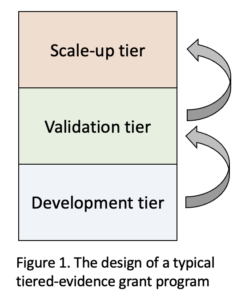 QUICK SUMMARY
QUICK SUMMARY
Tiered-evidence grant programs, also called innovation funds, are a way for public agencies to design competitive grant programs to emphasize and incentivize both evidence and innovation. In particular, they provide larger grants to applicants with approaches backed by stronger evidence of effectiveness, while providing smaller grants to applicants with approaches that are innovative but less tested.
 STRATEGY DETAILS
STRATEGY DETAILS
Q1. What are tiered-evidence grants?
 Tiered-evidence grants, also called innovation funds, are grant programs specifically designed to make grant making more evidence- and data-focused. They operate, in a way, like a venture capital fund: investors (public agencies, in this case) place bigger bets on approaches with more evidence of success and use smaller bets to encourage new and innovative approaches. The approach is called staged funding. In particular, most tiered-evidence grant programs have three tiers, as shown in Figure 1. That includes:
Tiered-evidence grants, also called innovation funds, are grant programs specifically designed to make grant making more evidence- and data-focused. They operate, in a way, like a venture capital fund: investors (public agencies, in this case) place bigger bets on approaches with more evidence of success and use smaller bets to encourage new and innovative approaches. The approach is called staged funding. In particular, most tiered-evidence grant programs have three tiers, as shown in Figure 1. That includes:
- Scale-up grants fund expansion or replication of practices with existing strong evidence. These grants receive the largest grants in order to expand proven practices.
- Validation grants fund promising practices with existing moderate evidence. These grants are medium sized.
- Development grants fund high-potential and relatively untested practices. These receive the least funding.
Applicants apply to a specific tier depending on how much evidence is backing their program or project for which they are seeking funding. Importantly, all three tiers come with funding for program evaluation, so grantees (especially in the validation and development tiers) can try to move up tiers over time as they gain stronger evidence, as symbolized by the gray arrows to the right of Figure 1.
Some programs use different names for the three tiers, as you'll see in the examples. Moreover, a few programs take a simpler approach and only have two tiers, so you can customize the approach to fit your agency's or program's needs.
Q2. What are example programs?
Example include Development Innovation Ventures (DIV) at U.S. Agency for International Development, which is designed to find, test, and scale ideas that could radically improve global prosperity. DIV has a budget of around $15 million and has three tiers: "Transition to Scale" grants of up to $15 million; "Test and Position for Scale" grants of up to $1.5 million; and Pilot grants of up to $200,000.
Another example is the Education Innovation and Research (EIR) Program at the U.S. Department of Education. It provides funding to generate and validate solutions to persistent educational challenges and to support the expansion of effective solutions to serve substantially larger numbers of students. With a budget of about $180 million, EIR's three tiers are called “Early-phase” grants of up to $4 million, “Mid-phase” grants of up to $8 million, and “Expansion” grants of up to $15 million.
Right now tiered-evidence grant programs only exist at the federal level, but there's no reason why they couldn't be launched at the state or local level as well.
Q3. How do these types of programs support both evidence and innovation?
Tiered-evidence grant programs are designed to encourage both evidence and innovation. Without the scale-up tier, there wouldn't be the emphasis on putting most of the grant dollars behind evidence-based approaches. Without the development tier, however, there wouldn't be the opportunity to test out new innovations that currently don't have much evidence behind them.
Another way to view these programs is through the lens of managing risk. Tiered-evidence grant programs allow for risk taking at early stages of an innovation, while mitigating risk at later stages and ensuring that funding maximizes impacts per dollar spent.
Q4. What limitations of traditional grant designs do tiered-evidence models address?
Applicants to traditional grant programs often lack incentives to identify and use approaches backed by strong evidence. And traditional grants rarely help grantees build rigorous evidence about their approach or evaluate their program to determine whether its goals are being achieved. In addition, these grants usually do not encourage innovative but less-tested approaches. Tiered-evidence grants are designed to address those limitations.
Q5. What design choices should be considered?
Several choices are involved in designing tiered-evidence grants, including:
- Direct or indirect investment? Most tiered programs provide direct funding, but some, like the Social Innovation Fund (SIF), use a different approach. SIF selects intermediaries that then fund community organizations as sub-grantees.
- Leveraged or not? SIF is a leveraged grant program, which requires grantees to provide matching funds.
- Funding programs, products, or both? Most tiered grant programs fund other programs, but DIV funds both programs and products, such as those designed to help create safe power sources or reduce drinking water contamination.
- Use of evidence framework to develop an exit requirement? All tiered-evidence grant programs use evidence as an entry (i.e., application) requirement. But to support learning and enable grantees to move up tiers over time, programs may consider an exit requirement stipulating that each grantee must conduct an evaluation more rigorous than the evidence cited in the grant application. This design approach allows grant programs to build evidence and is most effective when they have the authority and funding to provide technical assistance on evaluation activities and program implementation.
Q6. What features make a grant program a good candidate for tiered-evidence grantmaking?
Those features include having a grant program focused on a priority area within an agency and with strong commitment from agency leadership; having well-defined outcome measures; having an evidence base about effective programs or interventions already exists; and the agency having statutory authorization that allows some variation in how services are delivered.
Q7. What's needed to define tiers?
Creating tiers requires defining what constitutes preliminary, moderate, and strong evidence. Together, those definitions form an evidence framework and establish the evidence standards projects must meet to receive funding. The best way to develop an evidence framework is to use an existing one as a model. Today, both the Teen Pregnancy Prevention and Home Visiting programs within the U.S. Department of Human Services are examples of well-defined models.
Q8. Are there legal barriers to turning a traditional grant program into a tiered-evidence program?
Program directors might assume that a program’s statutory authorization must explicitly outline a tiered structure for agencies to award different levels of funding based on the strength of evidence supporting a project model, but that's not the case. Most existing tiered-evidence programs have no specific statutory provisions authorizing different award levels based on evidence. For example, DIV and SIF established program designs, award levels, and competition criteria through either regulations or nonregulatory guidance.
Q9. How does running a tiered-evidence grant program compare to running a traditional grant program?
Some unique features of most or all tiered programs include:
- An extended planning period before a grant competition, during which the agency reviews and synthesizes relevant research and disseminates it to potential applicants, establishes evidence standards for funding that encourage applicants to identify and incorporate relevant research into their project plans, and works with management support offices to make necessary adjustments to competition timelines and procedures.
- Validation of evidence claims made by applicants. Tiered-evidence programs use expert reviewers with knowledge of the relevant research and of rigorous research methods. Teams of qualified researchers sometimes conduct a second review of top-scoring applications to ensure the studies cited by applicants used rigorous methodologies.
- Technical assistance to help grantees develop and implement strong evaluations. This assistance is sometimes provided by a federal contractor that supports all grantees for a given program. Some agencies convene meetings for grantees to share lessons learned and ideas on how to improve program performance and evaluation. Others incentivize applicants to partner with evaluators from day one rather than selecting grantees and then hiring someone to determine how to evaluate them.
- A review of lessons learned from prior funding cycles. Tiered-evidence program managers adjust future competitions based on knowledge and experience gained from previous competitions.
 ADDITIONAL RESOURCES
ADDITIONAL RESOURCES
- Book: Show Me the Evidence: Obama’s Fight for Rigor and Results in Social Policy, by Ron Haskins and Greg Margolis.
- Op-ed: "Fighting the Opioid Epidemic with Evidence and Innovation," by Andrew Feldman, Richard Frank and Christopher Spera. Note that while this piece focuses on the opioid epidemic, the same approach could apply to any agency's priority topic.
- Gov Innovator podcast interviews:
- Harnessing Silicon Valley funding approaches to drive breakthrough solutions in the public sector: Jeffrey Brown, USAID
- Insights for evidence-based grant making from the Teen Pregnancy Prevention Program: Evelyn Kappeler, U.S. Department of Health and Human Services
- Strengthening evidence-based grant making at the U.S. Department of Education: Jim Shelton, U.S. Department of Education
- Transforming Federal grant programs from compliance driven to results focused: Robert Gordon, formerly White House Office of Management and Budget
- How one Federal agency, CNCS, strengthened the role of evidence in a key grant program, AmeriCorps: Diana Epstein and Carla Ganiel, Corporation for National and Community Service
- The federal evidence agenda and lessons for state and local leaders: Ron Haskins, Brookings Institution
- Becoming an evidence focused grant-making organization: Kelly Fitzsimmons, Edna McConnell Clark Foundation
- Building an evidence base for agency programs: Chris Spera, Corporation for National and Community Service
 CUSTOMIZED ASSISTANCE
CUSTOMIZED ASSISTANCE
Please contact us if your organization needs help in designing a tiered-evidence grant program.
![]() PDF VERSION OF THIS PAGE (click here)
PDF VERSION OF THIS PAGE (click here)
